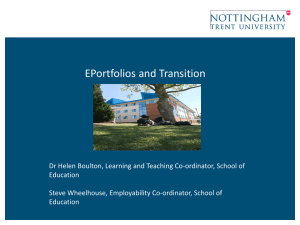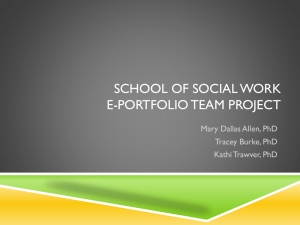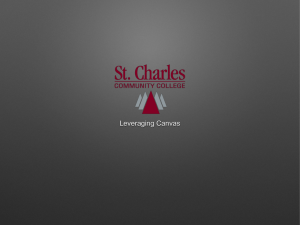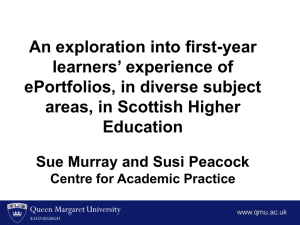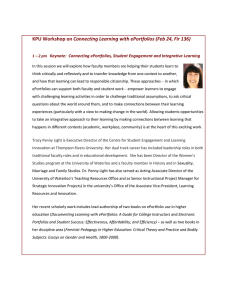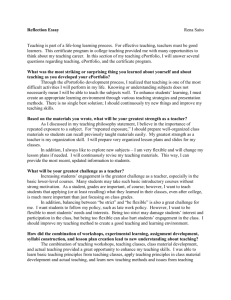Documenting Learning with Electronic Portfolios
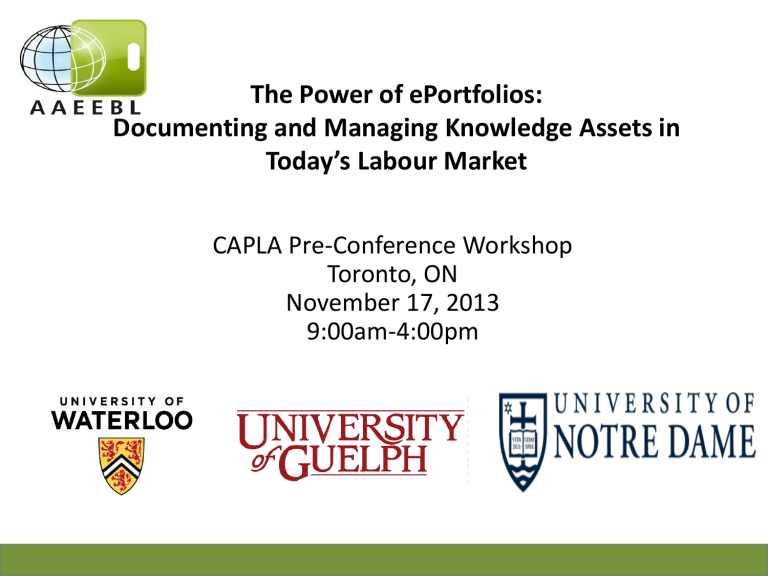
The Power of ePortfolios:
Documenting and Managing Knowledge Assets in
Today’s Labour Market
CAPLA Pre-Conference Workshop
Toronto, ON
November 17, 2013
9:00am-4:00pm
Who We Are
Tracy Penny Light, University of Waterloo/AAEEBL
Katherine Lithgow, University of Waterloo
Jason Thompson, University of Guelph
G. Alex Ambrose, University of Notre Dame
Trent Batson, President of AAEEBL
Judy Batson, Vice-President of AAEEBL
Today’s Overview
This Morning:
• Introductions and Icebreaker
• Documenting Learning with ePortfolios: An
Overview
This Afternoon:
• ePortfolios and Advising/Mentoring
• Planning for Implementation in Your Context:
Using a Logic Model
• Introducing AAEEBL and the ePortfolio
Community
• Questions
Take-Home Messages
• ePortfolios can be used for multiple purposes to engage a variety of stakeholders;
• ePortfolios allow users to collect, select, and present authentic evidence of/for learning in many contexts for a variety of purposes;
• ePortfolios are all about the PROCESS, therefore, it is essential to plan your implementation and activities around the OUTCOMES you wish to achieve with your STAKEHOLDERS
What ’ s in the Bag?
THINK :
What ’ s in YOUR bag?
How does it fit together?
How might you present it?
PAIR :
Discuss with a neighbour
SHARE :
Volunteer(s) to share with group as a whole
Portfolio
pɔːtˈfəʊlɪəʊ/
Noun
ePortfolio
… a set of pieces of [creative] work intended to demonstrate a person's ability
Prior Learning Assessment and Recognition
ePortfolio
(eP)
organize,
and
describe
their lifelong and life-wide learning.
This record of learning can then be presented in a way http://www.priorlearning.ca
What are ePortfolios?
Electronic portfolios (ePortfolios) are collections of digitally represented artifacts that:
• document practice
• include reflection
• integrate experience
• map to goals and/or standards
• promote deep learning and knowledge transfer
Documenting Learning with ePortfolios
Why Document Learning with ePortfolios?
• New technologies pushing boundaries for learners
▫ Globalized world, information is everywhere
• Increasing need for documentation of competencies and skills
▫ Learners need to learn ways to assess what it is that they know, understand and are able to do
• Rapidly changing context requires integration abilities
▫ ePortfolios provide opportunities for learners to reflect on, identify, organize, and describe their lifelong and life-wide learning = DIGITAL IDENTITY (LinkedIn)
• Need ways to help learners to “ make connections ” and demonstrate their knowledge
▫ Reflection and Action!
Folio Thinking: Reflection for
Learning
• Reflection is what makes us learners; we need to practice, assess and perfect it.
• Four criteria characterize the concept of reflection:
▫ Reflection is a meaning making process
▫ Reflection is systematic, rigorous and disciplined; with roots in scientific inquiry
▫ Reflection needs to happen in community
▫ Reflection requires attitudes that value personal and intellectual growth
From: Carol Rodgers, “ Defining Reflection: Another Look at John Dewey and Reflective
Thinking, ” Teachers College Record, 104, 4 (June 2002): 842-866
A Taxonomy of Reflection
A Taxonomy of Reflection
Creating: What should I do next?
Evaluating: How well did I do?
Analyzing: Do I see patterns in what I did?
Applying: Where could I use this again?
Understanding: What was important about it?
Remembering: What did I do?
Model Developed by Peter Pappas
ePortfolio Implementation
Framework
(Chen & Penny-Light, 2010; Penny-Light, Chen, & Ittelson, 2012)
•
Defining Learning Outcomes
• Identifying & Understanding
Learners and Stakeholders
• Designing Learning Activities
•
Informing Assessment of
Student Learning
•
Using ePortfolio Tools and
Technologies
•
Evaluating the Impact of Your ePortfolio Initiative http://www.documentinglearning.com
Identifying and
Understanding Learners and
Stakeholders
• Who are we designing the learning experience for?
• What are their characteristics?
• What technologies are they comfortable with?
• What support will they need to create their ePortfolios?
How does being continually connected affect how students interact with each other and how they experience college?
http://chronicle.com/article/Bleary-Eyed-Students-Cant/129838/
What’s being lost in this environment?
“We are being pummeled by a deluge of data and unless we create time and spaces in which to reflect , we will be left with only our reactions.”
--Rebecca Blood, weblog historian
• Communication skills (writing and in person)
• How to think
• How to be contemplative
• How to reflect
-Chronicle for Higher Education, 10/5/05
• Empathy?
--Konrath (2010)
Identifying and
Understanding Learners and
Stakeholders
• Who are we designing the learning experience for?
• What are their characteristics?
• What technologies are they comfortable with?
• What support will they need to create their ePortfolios?
Sketch
… who are the stakeholders for your ePortfolio project.
Don’t think too much. Put your pen to paper and start drawing.
Artifacts/Evidence in an ePortfolio
Identifying User Characteristics:
What data already exist?
• What methods can we use to learn about our ePortfolio learners?
• What existing sources of data are available and accessible? Who owns this data?
Brainstorm Strategies to Engage
Stakeholders
How will you communicate your vision for how ePortfolios can work in your context to your stakeholder of choice?
– WHO is your stakeholder?
– Why does your stakeholder NEED an ePortfolio?
– How can your stakeholder BENEFIT from the ePortfolio?
– What can your stakeholder CONTRIBUTE to the ePortfolio?
ePortfolio Implementation
Framework
(Chen & Penny-Light, 2010; Penny-Light, Chen, & Ittelson, 2012)
•
Defining Learning Outcomes
• Identifying & Understanding
Learners and Stakeholders
• Designing Learning Activities
•
Informing Assessment of
Student Learning
•
Using ePortfolio Tools and
Technologies
•
Evaluating the Impact of Your ePortfolio Initiative http://www.documentinglearning.com
Defining Learning Outcomes
• What learning outcomes are you currently implementing or considering for your ePortfolio initiative?
• What types of learning do you want to capture and document?
Association of American Colleges & Universities, http://www.aacu.org/leap/
24
25
Collection
Selection
Reflection
Direction/Goals
Presentation
Feedback
Portfolio
Portfolio Processes (Barrett,
2007)
Social Networking Technology
Connect
(Friending)
Listen
(Reading)
Posting
(Blogging)
Posting
(Publishing)
Share
(Linking/Tagging)
Respond
(Commenting)
Archiving
Listening/Thinking
Digital Storytelling
Collaborating
Publishing
University of Notre Dame
Career Services Skill List
Top 10 Skills:
Integrated from the following sources: 1. Ethical Conduct/Integrity
*National Association of Colleges and Employers (NACTE) Top 10 list
2. Critical Thinking/Analytical
Ability
* University Notre Dame Outcomes
*University Notre Dame Employer
Surveyed list of Skills (2005)
*Literature Review by Annie Selak
& Rose Kopec (2012)
3. Team Work
4. Verbal and Written
Communication
5. Initiative/Motivation Towards
Goals
6. Visionary/Innovative
7. Decision Making/Problem
Solving
8. Globally and Diverse Minded
9. Research/Project
10. Technical/Scientific
Career Development 31
https://nd.digication.com/spark_of_creativity/Milestone_Matrix/published
What are the organizing skills?
Portfolio
Skill Matrix
1 2
© gAlexAmbrose.com
3
Organized by: Standards, Objectives, Themes, Questions
(Site Map)
Evidence
= Artifact + Reflection
(Knowledge, Skills, & Disposition)
Reflection
Reflection on Action & For Action
(Description, What, So What, Now What?)
Artifact
= Shows what you Know and can Do
(Attach, Upload, Link or Embed text/visual/video)
Reflection
Reflection in Action
ePortfolio Implementation
Framework
(Chen & Penny-Light, 2010; Penny-Light, Chen, & Ittelson, 2012)
•
Defining Learning Outcomes
• Identifying & Understanding
Learners and Stakeholders
• Designing Learning Activities
•
Informing Assessment of
Student Learning
•
Using ePortfolio Tools and
Technologies
•
Evaluating the Impact of Your ePortfolio Initiative http://www.documentinglearning.com
Designing Learning Activities
• Given your outcomes, what activities can you design to best guide the ways that learners use the ePortfolio to document their learning?
• How will their learning be captured and documented in the ePortfolio? ARTIFACTS =
EVIDENCE
• How will stakeholders view that evidence?
Alignment in
Course/Program Design
Learning Outcomes
Teaching & Learning
Content &
Concepts
Methods
Assessment
Activities
Alignment in Program
Design
Outcomes
Employability/Pr omotion/
Artifacts are objects that provide evidence of what we know and can do
© gAlexAmbrose.com
Possible ePortfolio Artifacts
• What’s in your learner’s bag already that have been collected?
• What type of artifacts do you want to encourage them to create now?
• What activities will help them to create their artifacts?
*Remember…
REFLECTION!!
What ’ s your evidence?
Right now think of 2-3 pieces of evidence that can prove to yourself, parents, potential employer, and/or graduate admissions that could showcase (or that you would want to see):
Who you are?
What you know?
What you can do?
What you value?
What’s your story?
Why should I hire you?
What skills do you have?
Why you do what you do?
© gAlexAmbrose.com
Categories
Personal
Education
Career
Skills
E-Portfolio Categories & Artifacts (Walz, 2006)
Sub-Categories/Types
Identification Data
Documentation
Awards/Certifications
Service
Education History
Academic Record
Assessment Results
Documentation
Credentials
Career Inventory
Career Plan
Career Performance
Computer Skills
Learning Skills
Artifacts/Elements
Name/Email/Work Phone
Biographical Statement
Honors/Program certificates
Volunteer Projects
Current Enrollment
Transcript/Degree Audit
SAT/ACT Scores
Research Papers/Course Work
Resume/CV/Letters of Recommendation
Personality/Interests Inventory
Current Plan and Goals
Annual/Performance Reviews
Digital Projects/Works Samples
Personal/Professional Development
ePortfolio Implementation
Framework
(Chen & Penny-Light, 2010; Penny-Light, Chen, & Ittelson, 2012)
•
Defining Learning Outcomes
• Identifying & Understanding
Learners and Stakeholders
• Designing Learning Activities
•
Informing Assessment of
Learning
•
Using ePortfolio Tools and
Technologies
•
Evaluating the Impact of Your ePortfolio Initiative http://www.documentinglearning.com
Informing Assessment of Learning
• How do ePortfolios and their artifacts inform assessment of learning?
• What evidence is needed for learners to document their achievements and competencies?
ePortfolio Implementation
Framework
(Chen & Penny-Light, 2010; Penny-Light, Chen, & Ittelson, 2012)
•
Defining Learning Outcomes
• Identifying & Understanding
Learners and Stakeholders
• Designing Learning Activities
•
Informing Assessment of
Student Learning
•
Using ePortfolio Tools and
Technologies
•
Evaluating the Impact of Your ePortfolio Initiative http://www.documentinglearning.com
Using ePortfolio Tools and
Technologies
• Which ePortfolio tools and technologies will allow you to collect the types of evidence that will allow learners to document and demonstrate their learning?
ePortfolio Implementation
Framework
(Chen & Penny-Light, 2010; Penny-Light, Chen, & Ittelson, 2012)
•
Defining Learning Outcomes
• Identifying & Understanding
Learners and Stakeholders
• Designing Learning Activities
•
Informing Assessment of
Student Learning
•
Using ePortfolio Tools and
Technologies
•
Evaluating the Impact of Your ePortfolio Initiative http://www.documentinglearning.com
Evaluating the Impact of ePortfolios
• How will you evaluate the impact of your ePortfolio project?
• How will you define success for you? Your students? Your faculty? Your institution?
• What constitutes evidence of YOUR success?
Defining “Success”
(Venezsky, 2001)
•
Imagine that your ePortfolio project is completed and that it succeeded in all of its goals.
•
You are to appear tomorrow at a press conference to explain what you have accomplished.
•
Write a press release to distribute at this meeting.
Tips to Craft Your 56s ePortfolio
Elevator Pitch
inspired by http://www.alumni.hbs.edu/careers/pitch/
1. WHO : Describe who you are
2. WHAT : Describe how your ePortfolio project addresses the stakeholder’s NEED or problem
3. WHY : Describe the unique benefits of your ePortfolio project and how it adds value
4. GOAL : Describe the goals and time frame for your ePortfolio project and be clear what you are asking for.
Additional Suggestions
• Keep it short
• Have a hook or tagline
• Listen & be flexible – this is the start of a conversation
• Avoid jargon, buzzwords
• Be passionate
• Be careful not to sound like a memorized monologue
• Revise
• PRACTICE!
ePortfolio Implementation Framework for YOUR Stakeholder
Defining learning outcomes
Identifying and understanding learners and stakeholders
Designing learning activities
Informing assessment
Using ePortfolio tools and technologies
Evaluating the impact of your ePortfolio initiative
What learning outcomes does your stakeholder care about? What learning outcomes do you have for your stakeholder?
Who are they? How can they contribute
AND how do they benefit from your ePortfolio initiative?
Given your outcomes, what activities will guide what goes into the ePortfolio?
How does the ePortfolio content inform the assessment needs of your stakeholder?
What ePortfolio features does your stakeholder need?
How do you define “success” for your stakeholder?
What we’ve accomplished so far…
1. Introduced the ePortfolio Implementation
Framework
2. Identified the STAKEHOLDERS for your ePortfolio project
3. Benchmarked how an ePortfolio can address the
NEEDS of one of your stakeholders
4. Brainstormed STRATEGIES to frame ePortfolios persuasively to address the needs of your stakeholder(s)
5. Prototype an “elevator PITCH ” to your stakeholder of choice
What we’ll do after lunch…
• Consider Advising, Counselling, and Mentoring with ePortfolios
• Assist You in Developing Your Own
Implementation Plans
• Ask Questions/Discuss ePortfolios
Advising, Counseling, & Mentoring with ePortfolios
G. Alex Ambrose, Ph.D, University of Notre Dame
Academic Advisor and Co-Director, Balfour Hesburgh Scholars Program
Interim Coordinator, Notre Dame ePortfolio Engagement Program
Purpose(s)
Use(s)
Level(s)
Context(s)
Access
User(s)
Types
Workspace Show Case
© G. Alex Ambrose
Government Applications
Professional Applications
Educational Applications
Personal Applications
Public Usage of E-Portfolios to build a Productive and Employed Citizenry
“The role of e-Portfolios must likewise be situated within a larger critical discussion about the relationship between citizens and employers and the responsibility of the State. While also helping individuals develop their employability, e-portfolios out to contribute to creating agency, satisfaction, and meaning in their lives as wholes.”
(Cambridge, 2008, p.3)
(Cambridge, 2008, p.3)
First Generation Attributes
significant lag between persistence and graduation rates
(Carey, 2004; Kinzie et al., 2008; Pike & Kuh, 2005). twice as likely to depart after the first year (Choy, 2001) represent approximately 30% of attendees at U.S. postsecondary institutions and will be the new majority student by 2020 (Weaver,
2011).
less likely to develop relationships with faculty
(Pike & Kuh, 2005; Richardson & Skinner, 1992; Terenzini et al., 1996). quantity of advisor meetings was as a significant predictor of student retention: for each advisor meeting, the odds that a student would be retained increased by 13% (Swecker et. al, 2013)
58
Government Applications
Professional Applications
Educational Applications
Personal Applications
Skills Gap
© G. Alex Ambrose
Content Vs. Skills War
© G. Alex Ambrose
Hard Vs. Soft Skills Battle
Ethics/Privacy
Database
C-S Database
Languages
Security
Object-Oriented problem solving critical thinking teamwork oral communication creative thinking written communication
The Skills Gap & Employers
“ In addition to a resume or college transcript, more than four in five employers say an electronic portfolio would be useful to them in ensuring that job applicants have the knowledge and skills they need to succeed in their company or organization."
(AAC&U Study by Hart Research Associates: It Takes More Than A Major: Employer Priorities for
College Learning and Student Success , page 4).
Focus Group Report: What do ND's top recruiters say about Career ePortfolios?
When: April 26, 2013 the Notre Dame ePortfolio
Engagement Program (nDEEP) offered a presentation for the ND Career Center Employer Advisory Board
Who: 11 top campus recruiters from companies such as
AT&T, Accenture, Boeing, General Mills, General Electric,
Johnson and Johnson, P&G, and Stryker.
Link: http://eportfolio.nd.edu/news/39654-focus-groupreport-what-do-nd-s-top-recruiters-say-about-careereportfolios/
*91% (10/11) of recruiters said if a student followed up with them via email with a link to a relevant part of their ePortfolio they would visit it.
*73% (8/11) of recruiters said if a student offered to show them a relevant part of their ePortfolio during a job fair via tablet (iPad) they would be interested.
*64% (7/11) of recruiters said if a student put a link to their ePortfolio on the
top of their resume they would visit it.
*55% (6/11) of recruiters said if a student offered to show them a relevant part of their ePortfolio during a job interview via tablet (iPad) they would be interested.
*36% (4/11) of recruiters said if a student had a link to their ePortfolio on their
email signature or referenced in their cover letter that they would visit it.
Students, first and foremost, need to be impressive and interesting. Before
and after the interview seemed to be the best time to email a follow up with relevant parts to the ePortfolio. In addition, most agreed that they wouldn't mind the ePortfolio being shared in person via tablet during a job fair/interview only if it didn't replace the face-to-face interaction/pitch and didn't carry on
too long or become a distraction.
3 Organizational Perspectives
Outside In Within Inside Out
Adapted from (DeGeorge, 2010)
Government Applications
Professional Applications
Educational Applications
Personal Applications
Advisor: A Balanced, Tactical, Operational, and Strategic Perspective
Parent Student Instructors Advisor Administrators Accreditation Employer
How is my child doing?
Is the tuition worth it?
What’s my story?
Passion?
Interest?
What
I have learned?
How can I assess class learning objectives?
How can I engage students from my tactical, operational,
& strategic
Perspective?
Accountability
?
How can we bridge
Univ mission
Vision, with program goals?
Do you have proof that your students
Can you show me are meeting your outcomes and standards?
evidence of what you can do and what you know?
Tuition
© G. Alex Ambrose
Growth Learning Engagement Accountability Accreditation Skills
Transactional
Asynchronous Online:
Student emails advisor a question, and advisor answers
+
Surface-Level
Synchronous Face-to-face:
Student and advisor engage in mundane small talk and reintroductions
=
Old Paradigm
Pins & Paperwork
Transformational
+
Deep
=
New Paradigm
Asynchronous Online:
Student comes in prepared and pre-engaged with his/her eportfolio
Synchronous Face-to-face:
Student and advisor engage through deeper and more meaningful interaction by discussing the eportfolio
Passions & Purpose
Ambrose, G., & Williamson Ambrose, L. (2013).
The Blended Advising Model: Transforming Advising with ePortfolios .
International Journal of ePortfolio (IJeP), 3(1), 75-89.
Traditional
Advising
Strengths of
Blended
Advising
Strengths of
Distance
Advising
On Campus Online
Ambrose, G., & Williamson Ambrose, L. (2013).
The Blended Advising Model: Transforming Advising with ePortfolios .
International Journal of ePortfolio (IJeP), 3(1), 75-89.
Pre-Engage
Asynchronous Online: Student “ does his/her homework ” and prepares for advising session by posting reflections on an ePortfolio based on prompts from the advising syllabus
Re-Engage
Asynchronous Online: Student is able to capture, archive, reflect and review important documents, forms, and academic plans in the ePortfolio. “ Show me you have done something and thought about it ”
The Blended
Advising
Model:
Flipping the
Process with ePortfolios
Engage
Face-to-Face Advising Session: Student is engaged through deeper and more meaningful interaction by discussing reflections, clarifying goals, and reviewing artifacts and evidence of growth from the ePortfolio. “ Help me, help you ”
Ambrose, G., & Williamson Ambrose, L. (2013).
The Blended Advising Model: Transforming Advising with ePortfolios . International Journal of ePortfolio (IJeP), 3(1), 75-89.
STUDENT USES IT UPLOADS &
COLLECTS
SAMPLES
2 ND YEAR
STUDENT USES IT TO ID SKILLS &
PASSIONS
ACADEMIC INTEREST
STUDENT USE IT FOR STUDY
ABOARD
REFLECTION
ALUMNI SERVICES USE IT TO ORGANIZE A NETWORK
AND COLLECT QUALITATIVE AND LONGITUDINAL DATA
3 RD YEAR
CAREER SERVICES USE IT FOR DIGITAL
RESUME &
DOSSIER
INDIVIDUAL USES IT FOR LIFELONG LEARNING
BEYOND
EMPLOYEE USES IT FOR PROFESSIONAL
DEVELOPMENT
ADVISOR USES IT FOR LEARNING CONTRACT,
PLAN & STRATEGIES
STUDENT COLLECTS
LTRS OF REC
STUDENT USES IT TO GET INTO GRAD
SCHOOL
STUDENT BUILDS AN
E-PORTFOLIO WITH THE SUPPORT
OF THEIR ADVISOR
© gAlexAmbrose.com
1 ST YR
STUDENT USE IT FOR
APPLYING FOR INTERNSHIP
STUDENT USE IT FOR
SENIOR PROJECT/THESIS
4 TH YEAR
Advising & Study Abroad
73
Sr. Peer Advising, Service, & University Outcomes
74
Government Applications
Professional Applications
Educational Applications
Personal Applications
21
st
Century Motivation
Theory
• Major differences:
– extrinsic vs.
– intrinsic motivation
• Elements of True
(Intrinsic) Motivation:
– Autonomy
– Mastery
– Purpose
Managing Oneself
• What are my strengths?
• How do I perform?
• What are my values?
• Where do I belong?
• What should I contribute?
“Success in the knowledge economy comes to those who know themselves...”
Peter Drucker, (2005) Harvard Business Review
X-AXIS
LIVEWIDE
DIMENSION
Graduate School
College
FORMAL
LEARNING
High School
Middle School
Primary School
Kindergarten
GRAVE
Conferences
Journals
Associations
Hobbies
Travel
Y- AXIS
LIIFELONG
DIMENSION
Reading
Sports
Clubs
Volunteer
INFORMAL
LEARNING
© gAlexAmbrose.com
CRADLE
Adapted from (Chen, 2009)
The Ultimate
21 st C.
Swiss Army Knife
Educational
© gAlexAmbrose.com
Using a logic model to help you use the ePortfolio Implementation
Framework
Why a Logic Model?
• A tool that can facilitate discussion and illustrate the thinking behind programming decisions
• Takes assumptions and external factors into consideration
• Can help us identify ways to measure the success of programs
• It is a visual and helps communicate our plans and assumptions to a number of audiences
• If used repeatedly, it provides a common approach for all decisions
INPUTS
Activities
OUTPUTS
Participation Short
OUTCOMES
Medium Long
DESIRED
IMPACT?
What we need to start or keep something going?
What Learning
Portfolio activities you will implement given these resourcess
Who we engage in our activities
How effective are the activities?
Begin with 5+ year outcomes
Think
Backward
Design
(Wiggins and McTighe, 1998)
Move to the 3 year outcomes
Think
SMART
1 year outcome- What does
Success look like in one year?
Inputs
Could be the barriers, risk factors, limiting policies
Learning logs how many?
How many students in your course?
How will you provide feedback?
Projected Activities
Who are we designing the learning experience for?
Who we reach
Assumptions
• Who are your learners?
• What technologies are they comfortable with?
• What support will they need to create their ePortfolios?
•
What are their characteristics?
External Factors
Measuring Outcomes
Measuring Success Short
Term
Measuring Success Long
Term
Complete the Logic Model
• What is the Desired Impact?
• What does success look like 5 years from now? 2 years from now? 1 year from now?
• What will your learners know, understand, and/or be able to do as a result of the ePortfolio activity?
Planning for Effective Implementation:
Six + One Steps for Learner Engagement
1. Introduce the Learning Portfolio Activity Early and Communicate Expectations
2. Give ‘em Grades
3. Provide Feedback Early and Often
4. Respect Disciplinary Context
5. Provide Opportunities for Meaning Making
6. Recognizing ePortfolios as a threshold concept
+ Assess Impact
Planning for Effective
Implementation
• Introduce the Learning Portfolio Activity early and communicate expectations
– Emphasis on the process as well as the product
Teamwork Enabling
Competency
• The professional accounting bodies have identified teamwork as a required enabling competency. Working as part of a team is a critical skill for professional accountants. Over the course of this term and throughout the accounting program both in individual courses and your work terms, you will be given opportunities to benchmark, develop and enhance your teamwork skills.
Introduce early and communicate expectations
You will begin this by completing three reflective activities. You will receive feedback from reviewers (professional accountants or business people). You will then be asked to react to the feedback you received. The purpose of these activities is to help you examine more closely your strengths and weaknesses using templates provided; and further develop yourself in this area,
informed by feedback from your team members and from the reviewers . Through reacting to the feedback provided you will commit to a number of initiatives/goals between the current benchmarking and your next reflective activity. You will use
LEARN'S ePortfolio to create, store and submit your artifacts,
reflections, collections and presentations.
• Include you Learning Outcomes
Planning for Effective
Implementation : Six + One Steps
Step Two:
Give ‘em Grades
Activities and Assignments
Class Discussion Activities
Group Research Assignment
Reflections ePortfolio Presentation
Weight (%)
20%
20%
15%
45%
Planning for Effective
Implementation : Six + One
Steps
Step Three:
Provide Feedback Early and Often
• Reflections/Assignments – students receive instructor feedback on their writing and connections;
• Discussions – feedback from instructor and peers on ideas
• ePortfolio Peer Review – feedback from peers on ideas/structure/presentation
Feedback early and often
• Week 1- 2 Introduction to assignment
• Week 2 -3 Low stakes activity – required submission with grades. Students share their eportfolio artifact/presentation.
• Week 3-4 – In class hands-on session to address any problems.
• Week 7submit ePortfolio in progresscirculate to a team member for feedback
• Week 10peer feedback due
• Week 12eportfolios due
• Week 13 – presentation to class
Planning for Effective
Implementation : Six + One Steps
Step Four:
Disciplinary Context
• Importance of Making Connections
• “Real-world” Content
• Relate the activity directly to the needs and interests of the learners as members of a discipline/profession/community
ePortfolios in SAF
AFM 131- team work – 1A –Benchmarking
SPCOM 111- Oral Communication – 1B
1 st Co-op- Re-visit Team Work – 2B
2 nd Co-op Revisit Communication
Planning for Effective
Implementation : Six + One
Steps
Step Five:
Provide Opportunities for Meaning-Making
• Reflections
• Journals
• Films, TV, News
• Class Discussions
* PLAR- focus on what you have learned from what you have done
Planning for Effective
Implementation : Six + One
Steps
Step Six:
Provide Support Resources
• Introduction to ePortfolio in class (Hands-on
Workshop)
• Drop-in sessions throughout the term
• LEARN help support
• Online documentation
Providing Support
• Week 1- 2 Introduction to assignment
• Week 2 -3 Low stakes activity – required submission with grades. Students share their eportfolio artifact/presentation.
• Week 3-4 – In class hands-on session to address any problems. Technical support available throughout term
• Week 7submit ePortfolio in progresscirculate to a team member for feedback
• Week 10peer feedback due
• Week 12eportfolios due
• Week 13 – presentation to class
Planning for Effective
Implementation :
Assess Impact
Q. How does the ePortfolio allow students to make connections to their own life?
How does the ePortfolio allow them to document their learning?
Evidence of Effectiveness
1. What kinds of artifacts are learners including?
2. What can we tangibly see about learning that we couldn’t see before?
3. What does this Portfolio tell us about the individual’s process of learning?
4. What is useful to know about the context in which the learning takes place?
5. How is this ePortfolio relevant (or not relevant to your interests, organizational culture, learners or learning environment)?
Designing Learning Activities
• Given your chosen outcome, design one activity that learners can engage in and then include in the Learning Portfolio to document their learning
• Be sure to consider how will their learning be captured and documented in the Learning
Portfolio?
• Ensure that there is some reflective component to the activity ( Folio Thinking )
Folio Thinking: Reflection for
Learning
• Reflection is what makes us learners; we need to practice, assess and perfect it.
• Four criteria characterize the concept of reflection:
▫ Reflection is a meaning making process
▫ Reflection is systematic, rigorous and disciplined; with roots in scientific inquiry
▫ Reflection needs to happen in community
▫ Reflection requires attitudes that value personal and intellectual growth
From: Carol Rodgers, “ Defining Reflection: Another Look at John Dewey and Reflective
Thinking, ” Teachers College Record, 104, 4 (June 2002): 842-866
AAEEBL.org
Association for Authentic,
Experiential and Evidence-Based
Learning www.aaeebl.org
AAEEBL.org Site
www.aaeebl.org
The Essence of AAEEBL
• New forms of learning:
– For the sake of learning
– Employment
– Conveying your story (assessment)
– New forms of learning for a fuller life
• Engaged Learning
– High-Impact Practices
– Learning-centered learning
– Recent research into how humans learn
– Affordances of information technology
– In college or university and for life www.aaeebl.org
AAEEBL’s Services
• U. S. non-profit
• 5 years old
• Represents the eportfolio establishment and eportfolio providers
• International
• Holding the center as eportfolios spread rapidly
• Institutional memberships
• Corporate Partnerships
Why Are ePortfolios
Important?
• Learner/worker/individual – owned
• Can present many website views with evidence appropriate to occasion.
• Learning space; reflection, integration, evolution of self
• Meets demand of employers for fuller documentation, actual evidence of achievement.
• Creates continuity over a lifetime
• Advances life opportunities
AAEEBL and CAPLA
• Collaboration?
• Similar organizational goals
• Compatible orientation
• Can reinforce each other’s work
• Canadian AAEEBL chapter?
• trentbatson@mac.com
• judybatson@me.com
• Thank you www.aaeebl.org
Contact Us:
Tracy Penny Light – tplight@uwaterloo.ca
Katherine Lithgow – klithgow@uwaterloo.ca
Jason Thompson – jathomps@uoguelph.ca
G. Alex Ambrose – gambrose@nd.edu
Trent Batson – trentbatson@mac.com
Judy Williamson Batson – judybatson@me.com

